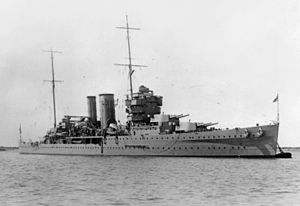HMS York (90)

York at anchor, 1930
|
|
| History | |
|---|---|
|
|
|
| Name: | HMS York |
| Ordered: | 21 October 1926 |
| Builder: | Palmers Shipbuilding and Iron Company, Jarrow |
| Laid down: | 16 May 1927 |
| Launched: | 17 July 1928 |
| Commissioned: | 1 May 1930 |
| Identification: | Pennant number: 90 |
| Fate: |
|
| General characteristics (as built) | |
| Class and type: | York-class heavy cruiser |
| Displacement: | |
| Length: | 575 ft (175.3 m) |
| Beam: | 57 ft (17.4 m) |
| Draught: | 20 ft 3 in (6.2 m) |
| Installed power: |
|
| Propulsion: | 4 shafts, Parsons geared steam turbines |
| Speed: | 32.25 knots (59.73 km/h; 37.11 mph) |
| Range: | 10,000 nmi (19,000 km; 12,000 mi) at 14 knots (26 km/h; 16 mph) |
| Complement: | 628 |
| Armament: |
|
| Armour: | |
HMS York was the first of two York-class heavy cruisers built for the Royal Navy in the late 1920s. She mostly served on the North America and West Indies Station before World War II. Early in the war the ship escorted convoys in the Atlantic and participated in the Norwegian Campaign in 1940. York was transferred to the Mediterranean theatre in late 1940 where she escorted convoys and the larger ships of the Mediterranean Fleet. She was wrecked in an attack by Italian explosive motorboats of the 10th Flotilla MAS at Suda Bay, Crete in March 1941. The ship's wreck was salvaged in 1952 and scrapped in Bari.
York's design was based on the earlier County classes but was intended to be smaller and cheaper, although better armoured. She was easily distinguishable from her sister ship, Exeter, as the latter had straight masts and funnels, while those of York were angled to the rear. In addition, York also had a very tall bridge designed to clear the aircraft catapult originally planned to be carried on the superfiring ('B') gun turret forward.
...
Wikipedia
